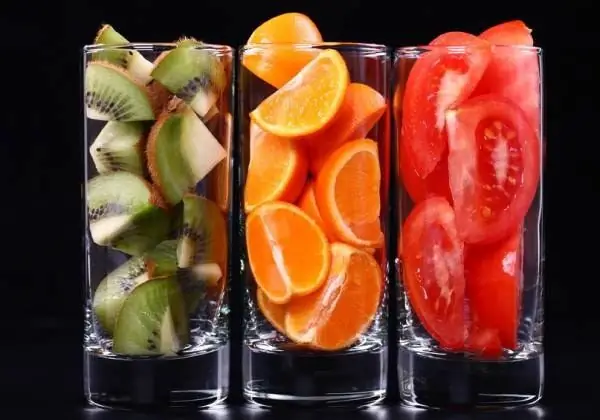- Author Brandon Turner [email protected].
- Public 2023-12-17 01:37.
- Last modified 2025-01-24 11:11.
The stores offer just a huge selection of packaged juices. Of all the variety presented, you are most likely to choose reconstituted juice, since there is too much water, sugar, and sometimes chemical additives in nectars, and not all manufacturers offer directly squeezed juice.

How is reconstituted juice made?
Recovered juices are based on fruit, vegetable or berry concentrates. It is made by evaporating or freezing water from natural juice squeezed from fruit raw materials. The concentrate looks like a thick viscous mass, reminiscent of jam or jelly.
To make juice, the concentrate is "steamed", heated, and then cooled. After that, water is added - its amount should correspond to the previously evaporated or frozen volume. Additives such as sugar or citric acid are acceptable, but acidulant and sugar can only be added separately.
Reconstituted juices are slightly more aromatic and tastier than directly squeezed juices. This is due to the fact that the juice recovery technology allows the use of a certain amount of aromatic substances.
After adding water, the homogenized juice undergoes heat treatment and is poured into packaging that allows you to preserve the freshness and taste of the product for the longest time possible.
Harmful or useful?
Of course, fresh juice is healthier than reconstituted juice. But freshly squeezed juices do not tolerate storage - they can be consumed within 20-30 minutes after preparation, then the vitamins in the juice begin to break down, and after a few hours fermentation can begin. A controlled technological process allows you to maximize the preservation of useful substances in the reconstituted juice during almost the entire storage period and to destroy microorganisms that can cause spoilage of the product.
Since both the concentrate before recovery and the ready-made reconstituted juice undergo pasteurization, part of the vitamins as a result of such multi-stage processing will inevitably be destroyed. Therefore, in order for the juice to be not only tasty, but also healthy, vitamins are often added to it, indicating this on the product packaging.
Pay attention to the shelf life of the juice - as it is stored, the content of vitamins and microelements naturally decreases, in the first six months after production, the amount of nutrients in the juice is maximum.
The quality of the raw materials from which the juice is made is strictly controlled - all fruits must be as fresh as possible, not have any damage or signs of decay.
There are a few things you can do to ensure that you don't fall victim to an unscrupulous manufacturer that uses low-quality raw materials or a concentrate with added sugar and flavors. Don't go for cheap - reconstituted juice can't be cheaper than nectar. The product may contain only juice, water, vitamin complexes, sugar or citric, ascorbic acids - there should not be any "flavors identical to natural" in the reconstituted juice.






